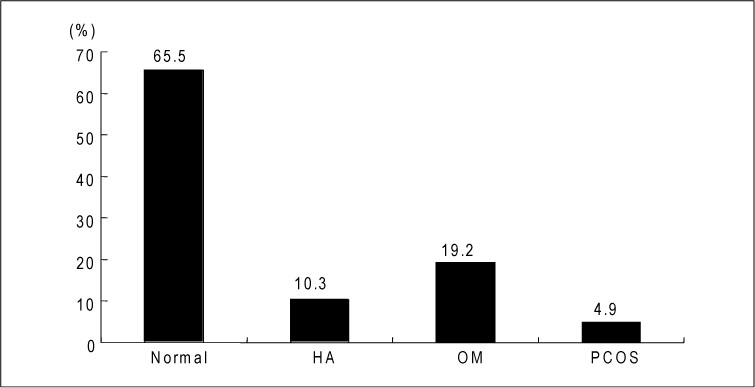J Korean Soc Endocrinol.
2005 Apr;20(2):120-126.
The Prevalence of Polycystic Ovary Syndrome in College Students from Seoul
- Affiliations
-
- 1Department of Internal Medicine, Ewha Womans University College of Medicine, Seoul, Korea.
Abstract
-
BACKGROUND: Polycystic ovary syndrome(PCOS) is characterized by the presence of chronic anovulation and hyperandrogenism, The prevalence of PCOS in premenopausal women of about 5~ 10%. There may be significant ethnic and racial variations in the prevalence and clinical presentation of PCOS. The current study was undertaken to determine the prevalence of PCOS and to identify the clinical characteristics of PCOS in Korea.
METHODS
From March 2003 to March 2004, medical students from Ewha Womans University were investigated for the prevalence of PCOS. The evaluation included a history and physical examination, a modified Ferriman-Gallwey hirsutism score and screening for hyperandrogenemia. PCOS was diagnosed by the presence of the following: 1) oligomenorrhea, 2) hyperandrogenemia and/or hirsutism(a modified Ferriman-Gallwey score> or =6), and 3) the exclusion of related disorders. Hyperandrogenemia was defined as a free testosterone level above the 95th percentile of that for normal cycling nonhirsute women.
RESULTS
Out of 492 students, 386 replied to the questionnaire and 203 students(19~31 yr of age) participated in the physical examination and blood sampling. Eumenorrhea without hirsutism was present in 133 students(65.5%), oligomenorrhea was present in 39 students(19.2%), hyperandrogenism was present in 21 students(10.3%) and hirsutism was present in 3(1.5%) of the 203 women. The prevalence of PCOS was 4.9%(10 of 203 students), and only 2 of 10 women with PCOS were hirsute. The mean body mass index of students with PCOS was 22.7+/- 4.3kg/m2, and two women was obese. The plasma insulin levels during the 75g oral glucose tolerance test in women with PCOS was significantly higher when compared to the age and body mass index of the controls.
CONCLUSION
The prevalence of PCOS was 4.9% in college students from Seoul. This rate is similar to those rates reported by other investigators in Greece(6.7%) and United States(4%). Obesity and hirsutism are not common in Korean women with PCOS. We are planning to survey a more diverse age groups to determine the prevalence of PCOS
MeSH Terms
Figure
Reference
-
1. Carmina E, Lobo RA. Polycystic ovary syndrome (PCOS): arguably the most common endocrinopathy is associated with significant morbidity in women. J Clin Endocrinol Metab. 1999. 84:1897–1899.2. Solomon CG. The epidemiology of polycystic ovary syndrome. prevalence and associated disease risks. Endocrinol Metab Clin North Am. 1999. 28:247–263.3. Dunaif A, Givens JR, Haseltine FP, Merriam GR. Current issues in endocrinology and metabolism: polycystic ovary syndrome. 1992. Boston: Blackwell, Scientific.4. Zawadeski JK, Dunaif A. Dunaif A, editor. Diagnostic criteria for PCOS: towards a more rational approach. PCOS. 1992. Boston: Blackwell Scientific;377–384.5. The Rotterdam ESHRE/ASRM-sponsored PCOS consensus workshop group. Revised 2003 consensus on diagnostic criteria and long health risks related to polycystic ovary syndrome. Hum Reprod. 2004. 19:41–47.6. Legro RS. The genetics of polycystic ovary syndrome. Am J Med. 1995. 98:9S–16S.7. Norman RJ, Mahabeer S, Masters S. Ethnic differences in insulin and glucose response to glucose between white and Indian women with polycystic ovary syndrome. Fertil Steril. 1995. 63:58–62.8. The Asia-Pacific perspecitve: Redefining obesity and its treatment [article online]. 2000. Available from: http://www.diabetes.com.au/downloads/obesity-report.pdf.9. World Health Organization. Part1. Diagnosis and classification of diabetes mellitus. Definition, diagnosis and classification of diabetes mellitus and its complication: Report of a WHO consultation. 1999. Geneva: World Health Organization.10. Diamanki-Kandarakis E, Kouli CR, Bergiele AT, Filandra FA, Tsianateli TC, Spina GG, Zapanti ED, Bartzis MI. A survey of the polycystic ovary syndrome in the Greek island of Lesbos: hormonal and metabolic profile. J Clin Endocrinol Metab. 1999. 84:4006–4011.11. Asuncion M, Calvo RM, San Millan JL, sancho J, Avila S, Wscobar-Morreale HF. A prospective study of the prevalence of the polycystic ovary syndrome in unselected Caucasian women from Spain. J Clin Endocrinol Metab. 2000. 85:2434–2438.12. Michelmore KF, Balen AH, Dunger DB, Vessey MP. Polycystic ovaries and associated clinical and biochemical features in young women. Clin Endocrinol (Oxf). 1999. 51:779–786.13. Knochenhauer ES, Key TJ, Kahsar-Miller M, Waggoner W, Boots LR, Azziz R. Prevalence of the polycystic ovary syndrome in unselected black and white women of the southeastern United Sates: a prospective study. J Clin Endocrinol Metab. 1998. 83:3078–3082.14. Azziz R, Woods KS, Reyna R, Key TJ, Knochenhauer ES, Yildiz BO. The prevalence and features of the polycystic ovary syndrome in an unselected population. J Clin Endocrinol Metab. 2004. 89:2745–2749.15. Farquhar CM, Birdsall M, Manning P, Mitchell JM, France JT. The prevalence of polycystic ovaries on ultrasound scanning in a population of randomly selected women. Aust N Z J Obstet Gynaecol. 1994. 34:67–72.16. Swanson M, Sauerbrei EE, Copperberg PL. Medical implications of ultrasonically detected polycystic ovaries. J Clin Ultrasound. 1981. 9:219–222.17. Escobar-Morreale HF, Serrano-Gotarredona J, Garcia-Robles R, Sancho J, Barela C. Lack of an ovarian function influence on the increased adrenal androgen secretion present in women with functional ovarian hyperandrogenism. Fertil Steril. 1997. 67:654–662.18. Dunaif A, Sorbara L, Delson R. Ethnicity and polycystic ovary syndrome are associated with independent and additive decrease in insulin action in Caribbean Hispanic women. Diabetes. 1993. 42:1462–1468.19. Toscana V, Adamo MV, Caiola S. Is hirsutism and evolving syndrome? J Endocrinol. 1983. 97:379–338.20. Conway GS. Polycystic ovary syndrome: clinical aspects. Baillieres Clin Endocrinol Metab. 1996. 10:263–279.21. Carmina E, Koyama T, Chang L, Stanczyk FZ, Lobo RA. Does ethnicity influence the prevalence of adrenal hyperandrogenism and insulin resistance in polycystic ovary syndrome? Am J Obstet Gynecol. 1992. 167:1807–1812.22. Wijeyaratne CN, Balen AH, Barth JH, Belchetz PE. Clinical manifestations and insulin resistance IR in polycystic ovary syndrome PCOS among South Asians and Caucasians: is there a difference? Clin Endocrinol (Oxf). 2002. 57:343–350.
- Full Text Links
- Actions
-
Cited
- CITED
-
- Close
- Share
- Similar articles
-
- Medical diagnosis and treatment of polycystic ovary syndrome
- Epidemiology and Diagnostic Criteria of Polycystic Ovary Syndrome
- Polycystic Ovary Syndrome in Adolescence
- Studies on Fibrinolytic System Behavior in Women with Polycystic Ovary Syndrome
- Idiopathic Intracranial Hypertension in Patient with Polycystic Ovary Syndromes



